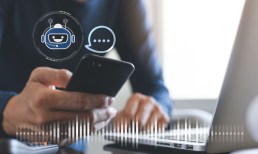Apart from being Inauguration Day in Washington, D.C., January 20, 2021 is also an important date for an almost completely unconnected reason. It was one year ago today that the first case of COVID-19 was diagnosed in the United States. Officially, the first case was called in Snohomish County, an area of fewer than one million residents north of Seattle. Then, in short order, it was everywhere.
To say that COVID-19 changed us all is putting it more than a little mildly. But how exactly have we changed? PYMNTS has been surveying consumers since the pandemic’s earliest days. We’ve learned that consumers have hit the reset button in the 10 or so months — in terms of what they do, what they expect and who they plan to be when “normal life” can resume again. Here are five of the most significant changes.
1. Consumers have gone from “no big deal” to ‘in it for the long haul.’
In our earliest consumer surveys, a large share of consumers believed the COVID-19 threat was blown a bit out of proportion. The data demonstrated that only a little over a third ( 36.9 percent) were “very” or “extremely” worried, while 48.4 percent were only “somewhat” or “slightly” concerned. Roughly 14.7 percent said they were not at all concerned.
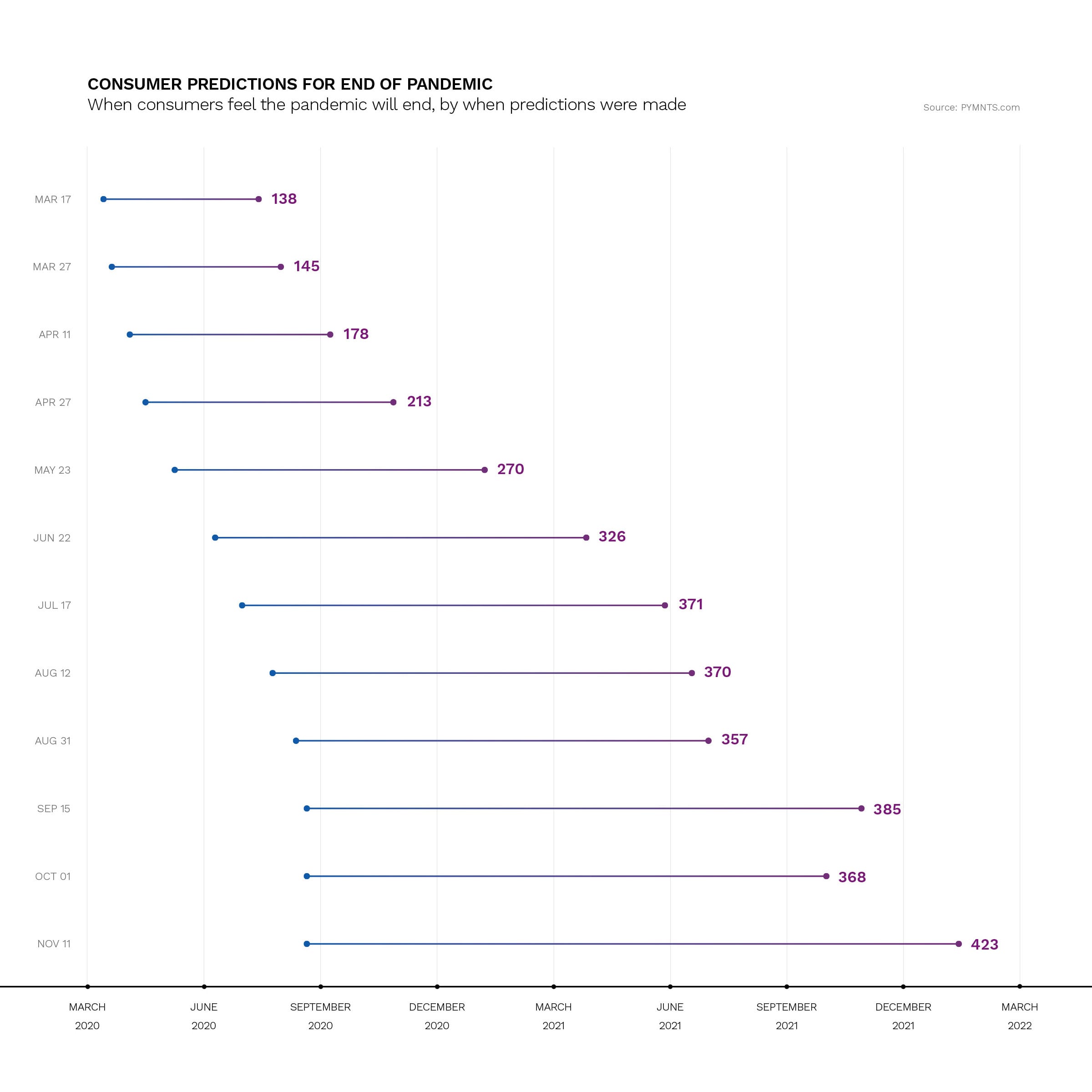 Moreover, a solid majority of consumers believed the threat was exaggerated, with 65.7 percent of consumers expressing that media coverage of the outbreak made it look at least “somewhat” more serious than it was at that point, while only 26 percent believed it was “accurate.”
Moreover, a solid majority of consumers believed the threat was exaggerated, with 65.7 percent of consumers expressing that media coverage of the outbreak made it look at least “somewhat” more serious than it was at that point, while only 26 percent believed it was “accurate.”
Jump ahead to late 2020 — 10 months, seven million cases and over 400,000 COVID-19 related fatalities later — and the PYMNTS data tells a different story. Consumers no longer think COVID was an overblown blip soon to blow over — in fact, they now believe they’re in this for the long haul. The majority of consumers do not expect things to go back to business as usual until January 2022.
Advertisement: Scroll to Continue
Consumers actually now expect the recovery to take longer than expected. PYMNTS found in October that consumers expected their lives to return to normal in 368 days, but in November they expected the recovery to last another 423 days.

2. Early concern does not correlate to high vaccine enthusiasm.
Though high levels of concern were not yet running rampant when we spoke to consumers in March of 2020, the responses highly correlated to age. Bridge millennials expressed the highest levels of concern, with 44.1 percent of consumers ages 32 to 41 either “very” or “extremely” concerned about COVID-19. This compares to 41.3 percent of millennials and 37.4 percent of Gen Xers who said the same.
Baby Boomers and seniors were, by comparison, the least worried, with just 32.9 percent saying they were “very” or “extremely” concerned about the outbreak.
But those early levels of high concern didn’t necessarily translate into high levels of enthusiasm for the vaccine among younger people, as vaccine news first started circulating in November. Interest in getting vaccinated, according to PYMNTS data, is particularly high among older generations: 46.5 percent of Baby Boomers and seniors are very or extremely likely to get vaccinated. That compares to around a third of millennials and bridge millennials (those born between 1979 and 1988) expressing the same level of interest in getting vaccinated. Baby Boomers’ and seniors’ relatively high levels of interest underpins their confidence in vaccines’ success rates. PYMNTS survey data shows that 39.4 percent of Baby Boomers and seniors are very or extremely confident in the success of the vaccines, whereas only 28.7 percent of millennials and 24.7 percent of Gen Z consumers feel as confident.
3. The vaccine has changed the ‘normal’ to which consumers plan to return.
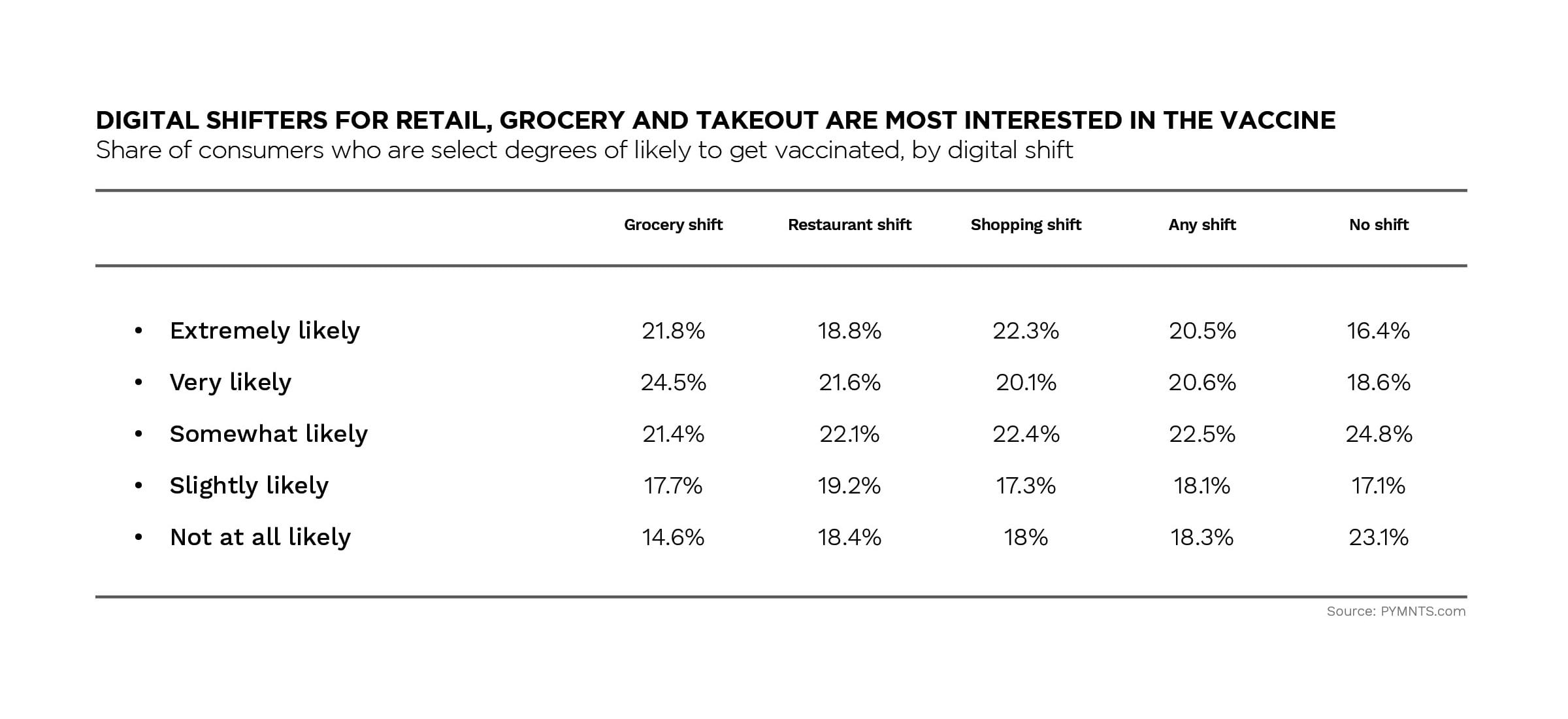
When asked in March what it would take to get them to resume their pre-COVID-19 lifestyles in regards to getting back to travel, a functioning vaccine led the list, with most consumers saying they would wait until the Centers for Disease Control (CDC) said it was safe. Even consumers who were only “somewhat” or “slightly” concerned about the virus were more likely than not to say that having the CDC declare travel safe would make them more inclined to resume their trips. Far fewer consumers — only 16.8 percent of “somewhat” and 14.4 percent of “slightly” concerned consumers — said that lowering the cost of airfare or lodging would entice them to travel again, however.
And yet our late 2020 data shows that although digitally shifted consumers are among the most likely to get a vaccine, they are also the least likely to ever return to the “old normal.” PYMNTS research shows that 42.3 percent of consumers who have shifted to digital for retail product shopping, 46.2 percent who have shifted for buying food at the grocery store and 40.4 percent of those who have shifted to ordering food for delivery or takeout at restaurants are likely to get vaccinated once a vaccine is available. The same data set reveals that of 54.7 percent of respondents who are at least slightly likely to get vaccinated and who increased their shopping through mobile devices, only 21 percent plan to revert to how they shopped before the pandemic.
4. The digital shift has been separate from pure virus concern from the beginning.
COVID-19 gets a lot of the credit, but the digital shift that jump-started in March existed even then as a separate entity from the pandemic.
Not all consumers were highly concerned about COVID-19 in early March, but most were still taking active measures to avoid the outbreak. PYMNTS data demonstrated that 17.1 percent of “somewhat” concerned consumers and 8.3 percent of “slightly” concerned ones were going to the store to buy food to cook at home less often than they did before the pandemic, and 27.8 percent of “somewhat” concerned consumers and 12 percent of “slightly” concerned ones were shopping for non-grocery goods in brick-and-mortar stores less often than they did before the pandemic.
This brick-and-mortar shopping decrease went hand in hand with an increase in digital shopping. The share of “somewhat” concerned consumers shopping online increased 18.4 percent after the outbreak began, while the share of “slightly” concerned consumers who did the same increased 10.2 percent.
And as the pandemic pushed into the latter half of the year and the vaccine appeared on the horizon, consumers seemed at least somewhat disposed to continue staying in. A significant share of consumers said they will continue to practice caution when it comes to engaging with the outside world, with 43.4 percent reporting they will leave their homes as much as they do now, whereas 52.4 percent would leave their house either more often or much more often once a vaccine is made available to them.
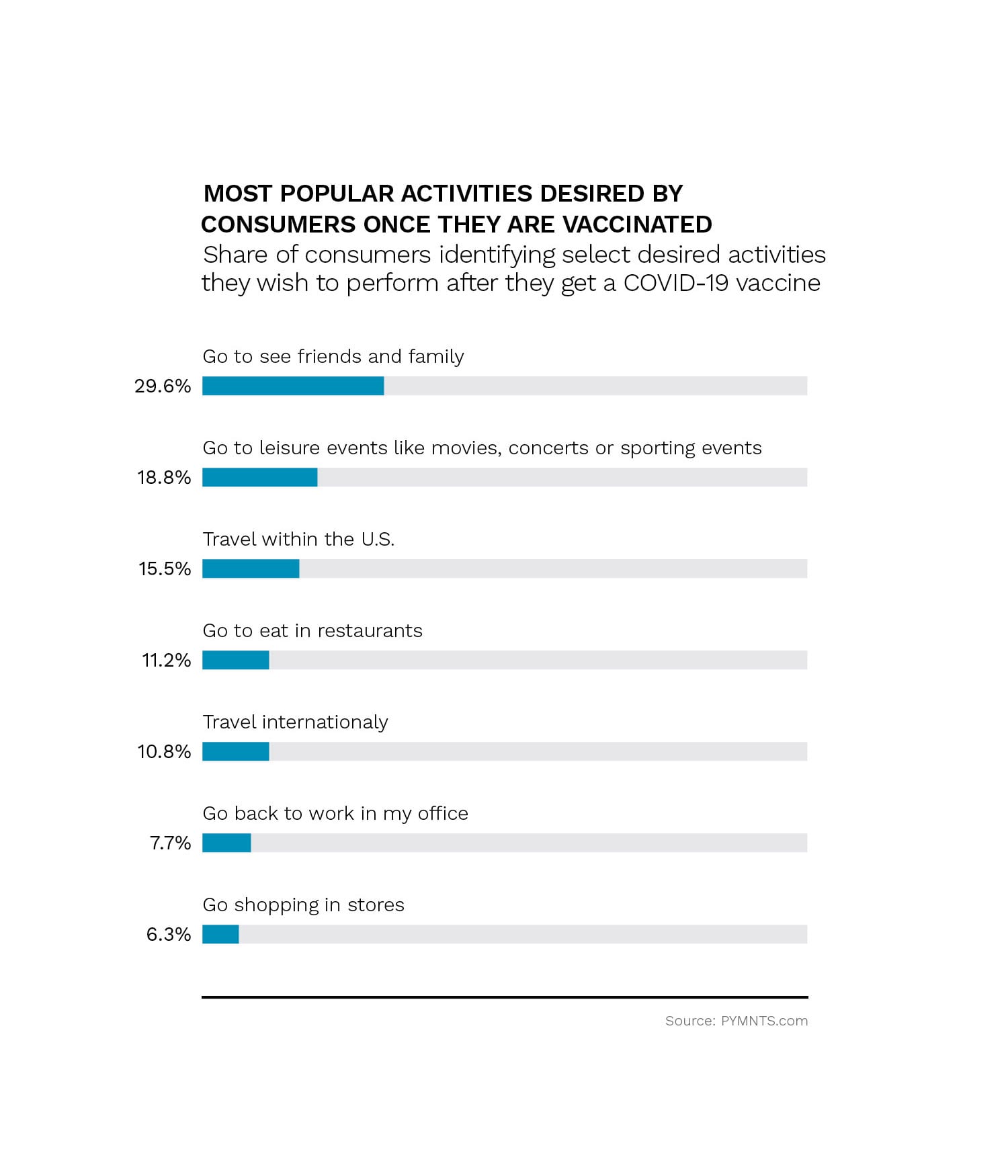
5. There are, however, some things they have missed.
Among the first consumer changes PYMNTS observed was the move to avoid crowds, even at the earliest stage of the pandemic. The only activities consumers reported doing more frequently after the outbreak than before were those they could do on their own. More consumers began working remotely after the outbreak, with 18.4 percent saying they were working from home more often. PYMNTS also saw an increase in the share of consumers shopping online.
Perhaps unsurprisingly, the activity consumers are mostly looking to resume is seeing family and friends again, with 29.6 percent reporting that as a top priority. PYMNTS’ data also found that 18.8 percent of consumers want to be able to engage in leisure activities like going to the movies or attending sporting events and concerts. Third-most cited was the desire to travel freely within the country (identified by 15.5 percent), followed by going out and eating in restaurants (reported by 11.2 percent).
The ability to travel internationally, go back into the office and shop in physical stores again were a priority for a relative minority of consumers. Consumers’ lack of interest in going back into an office and shopping in physical stores indicates that most have become used to performing those tasks online and prefer the ease or convenience of a digital setting.
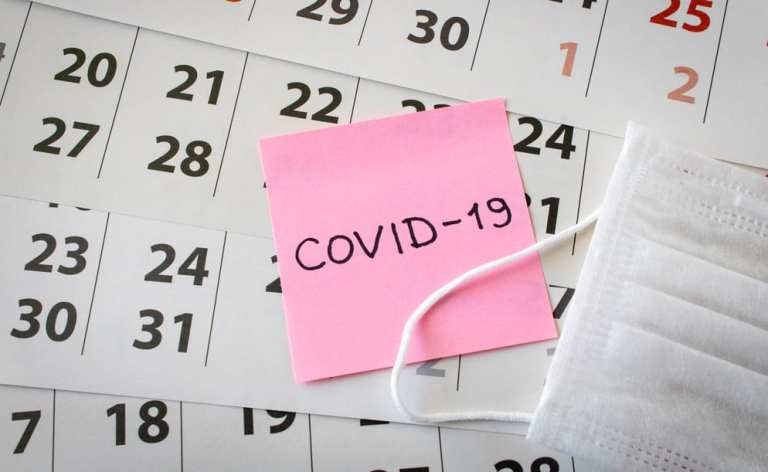
 Moreover, a solid majority of consumers believed the threat was exaggerated, with 65.7 percent of consumers expressing that media coverage of the outbreak made it look at least “somewhat” more serious than it was at that point, while only 26 percent believed it was “accurate.”
Moreover, a solid majority of consumers believed the threat was exaggerated, with 65.7 percent of consumers expressing that media coverage of the outbreak made it look at least “somewhat” more serious than it was at that point, while only 26 percent believed it was “accurate.”





